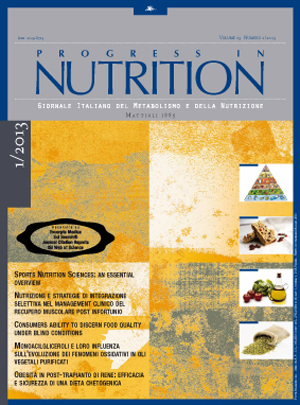Nutrizione e strategie di integrazione selettiva nel management clinico del recupero muscolare post infortunio
Keywords:
Muscle injury, bed rest, supplementations, muscle catabolism, Infortunio muscolare, riposo forzato, integratori, catabolismo muscolareAbstract
L’infortunio muscolare è un evento statisticamente molto frequente in chi pratica sport a livello sia professionale che amatoriale e tutt’altro che raro anche nella popolazione generale: quale che ne sia la causa esso determina un periodo più o meno prolungato di immobilità forzata o di ridotta mobilità, ingenerando perdite anche gravi di massa e forza muscolare con serie conseguenze sulla capacità di prestazione dello sportivo e sullo stato di salute in generale del non sportivo. Le cause di infortunio muscolare sono molteplici e possono essere grossolanamente suddivise in due grandi gruppi: i traumi diretti (contrasto di gioco,movimenti innaturali, ecc) ed i traumi indiretti (in cui le forze lesive si sviluppano nell’unità funzionale motoria). In entrambi i casi l’intervento nutrizionale si è comunque dimostrato un efficace strumento di supporto a quello ortopedico-fisiatrico e a quello fisioterapico-riabilitativo nella gestione clinica del recupero funzionale, ottimizzando le capacità anaboliche del muscolo,migliorando l’outcome e riducendo i tempi di recupero. Cardini di tale intervento sono la modulazione dell’apporto calorico, di quello proteico e delle eventuali integrazioni dietetiche, in funzione della durata delle diverse fasi in cui è possibile suddividere il recupero post-infortunio: il periodo immediatamente successivo all’infortunio stesso, il successivo periodo di riposo forzato e infine la fase di recupero funzionale. In tutte queste fasi l’integrazione della dieta con aminoacidi ramificati, altri aminoacidi come alanina, glutammina e arginina, creatina, idrossi-metil-butirrato, sali minerali (zinco, magnesio e calcio) e vitamine (vitamina C e vitamine del gruppo B), trova un suo razionale non solo nello sportivo,ma nella popolazione generale, nell’ottica di limitare il danno che l’infortunio può determinare, sia direttamente che indirettamente, a carico della massa muscolare.Nutrition and selective supplementation strategies in the clinical management of muscle injury recovery
Muscle injury is statistically a very frequent event in people playing sports both at an amateur and professional level and is far from rare in the general population: whatever the cause, it results in varying periods of forced immobility or reduced mobility, causing even a serious loss of muscle mass and strength, with serious consequences on a sportsman’s performance and on the general health status of a person who does not do sport. The causes of muscle injury are multiple and can be roughly divided into two big groups: direct traumas (tackles, unnatural movements etc.) and indirect traumas (in which harmful forces develop within the muscle structure). In both cases dietary intervention has proved to be an efficient tool in supporting orthopaedic physical therapy and physiotherapy and rehabilitation in the clinical management of functional recovery, optimising the muscle’s anabolic capacity, improving the outcome and reducing the healing time. The key points of such intervention are the regulation of calorie count and of protein intake, as well as of the possible dietary supplementation, depending on the duration of the various injury healing phases: the period immediately following the injury itself, the following period of bed rest and, finally, the functional recovery phase. In all these phases dietary supplementation with branched amino acids, other amino acids such as alanine, glutamine and arginine, creatinine, hydroxymethyl butyrate, mineral salts (zinc, magnesium and calcium) and vitamins (vitamin C and B-complex vitamins) is an approach that can be used not only in the sportsman but also in the general population, with the objective of limiting any damage the injury may cause, both directly and indirectly, to the muscle mass.
Downloads
Published
Issue
Section
License
This is an Open Access article distributed under the terms of the Creative Commons Attribution License (https://creativecommons.org/licenses/by-nc/4.0) which permits unrestricted use, distribution, and reproduction in any medium, provided the original work is properly cited.
Transfer of Copyright and Permission to Reproduce Parts of Published Papers.
Authors retain the copyright for their published work. No formal permission will be required to reproduce parts (tables or illustrations) of published papers, provided the source is quoted appropriately and reproduction has no commercial intent. Reproductions with commercial intent will require written permission and payment of royalties.

This work is licensed under a Creative Commons Attribution-NonCommercial 4.0 International License.


